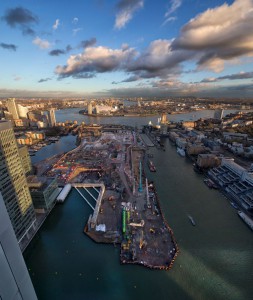SMARTWaste Case Study Interview: Canary Wharf Contractors Limited

Earlier this month, BRE Digital Tools’ Jo Goodwin sat with Callum Scott, Project Sustainability Manager for Canary Wharf Contractors Limited, (CWCL) the construction arm of the Canary Wharf Group, to find out more about their experiences with BRE SMARTWaste and how this helps their business.
Callum talks about how sustainability is key for CWCL, along with how digital tools such as SMARTWaste are helping his team to make better informed decisions and meet their goals.
So Callum, what are your responsibilities, and what draws you to sustainability?
At CWCL I oversee the implementation and continuous improvement of environmental management, including maintaining various certifications, handling planning through to handover. This involves management of consultants, contractors and other third parties to meet our sustainability and environmental objectives.
I have a background in civil engineering, and have always had in interest in the environment and construction which, in my eyes, are one and the same – construction impacts the environment and vice versa.
Tell me a little about Canary Wharf Contractors and sustainability:
It’s a big focus here for us at CWCL, as it simply makes good business sense – considering the long term impacts of energy, resources and other areas will allow for more effective planning, becoming more cost effective at the same time.
Improving sustainability and environmental performance within construction will allow for greater credibility within the community, sharing benefits such as employment opportunities. This is what the wider Canary Wharf Group is all about.
We have always had to address environmental legislation and high expectations from clients. Competition in this market demands a high standard of sustainability performance, and SMARTWaste allows us to communicate and deliver real improvements in this area.
How do you track and report on your environmental impacts?
Using BRE’s SMARTWaste tool, I’m able to gain a thorough understanding on how our projects are developing from an environmental perspective; looking at waste, energy and water use, transport, timber and materials used within our projects.
Site information is captured in the tool by our trade contractors, and I use this data to identify trends and areas for improvement, in addition to using the data for annual group reports, which are read by our clients.
What savings have been made as a result of using SMARTWaste?
Using SMARTWaste gives us the ability to communicate accurate KPI data across our suppliers via a ‘one stop shop’ industry-recognised system – helping us to achieve our own objectives and drive positive change across our projects and the business as a whole. This results in minimising complexity, resulting in valuable time savings that allow our teams to concentrate on being more efficient and improving performance
In addition to the time saving benefits of using SMARTWaste, the tool allows us to identify areas for improvement – such as excessive loss or waste, helping us to make informed decisions to improve performance.
Why did the business choose SMARTWaste as the tool to monitor and report on environmental impacts?
We needed to update our existing in-house and offline system to a web-based platform, with the main aim of allowing trades and site managers to access it externally.
I had previously used SMARTWaste and was familiar with the tool and how it can benefit an organisation, and so we were able to bring this on board.
It’s a tool that ticks all the right boxes. Going beyond a duty of care compliance, SMARTWaste is ideal for use on multiple sites, and when we looked at our projects and their scale and capacity – an ‘off the shelf’ solution suited our needs.
In addition to this, as an organisation with a keen focus on achieving BREEAM, it is a big benefit that SMARTWaste aligns with BREEAM principles.
What benefits have you seen from using SMARTWaste?
A highly tangible benefit for us is that SMARTWaste helps make data more transparent, creating more efficient processes and giving us vital information for our sustainability reports, in addition to helping us meet our FSC project certification and ISO50001 and 14001 certifications.
Recent changes to the tool have given us additional areas to monitor and report on, beyond waste – and this is already helping us to make changes and improvements within our projects and across the organisation as a whole.
It’s a huge help that SMARTWaste is ‘off the shelf’ as a lot of our staff and contractors are already familiar with the tool and how to use it, and those who aren’t are able to pick it up fairly easily – which saves us a lot of time in communication and data corrections due to unfamiliarity.
From a marketing perspective, having SMARTWaste allows us to really demonstrate our commitment and credibility around sustainability – something we know our clients care about.
SMARTWaste will play a key role in the delivery of all our BREEAM Post Construction rated buildings.
Looking ahead to tomorrow’s construction, how do you see digital tools like this helping the industry in the future?
Increasing the transparency and making environmental data more visible throughout a supply chain will allow for more instantaneous improvements. Connected digital systems like SMARTWaste mean less time number crunching and more time taking action to make these vital improvements, based on solid data.
For me, tools like SMARTWaste are starting to and I believe will continue, to affect the planning, design and specification areas of the industry.
Environmental data will impact decisions around choices and sourcing of materials used, methods of construction and even the physical design of buildings or infrastructure, all contributing to more sustainable, efficient and effective buildings and communities.
